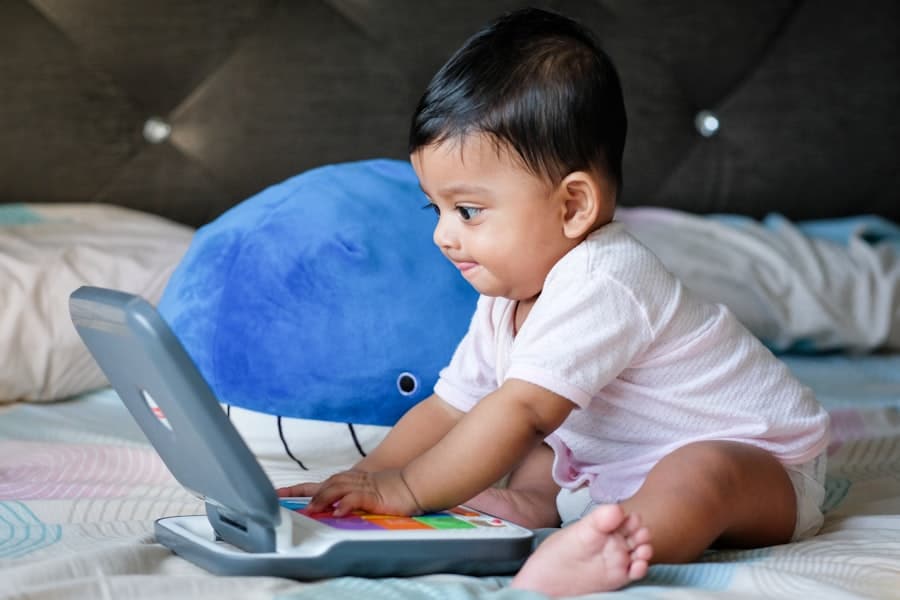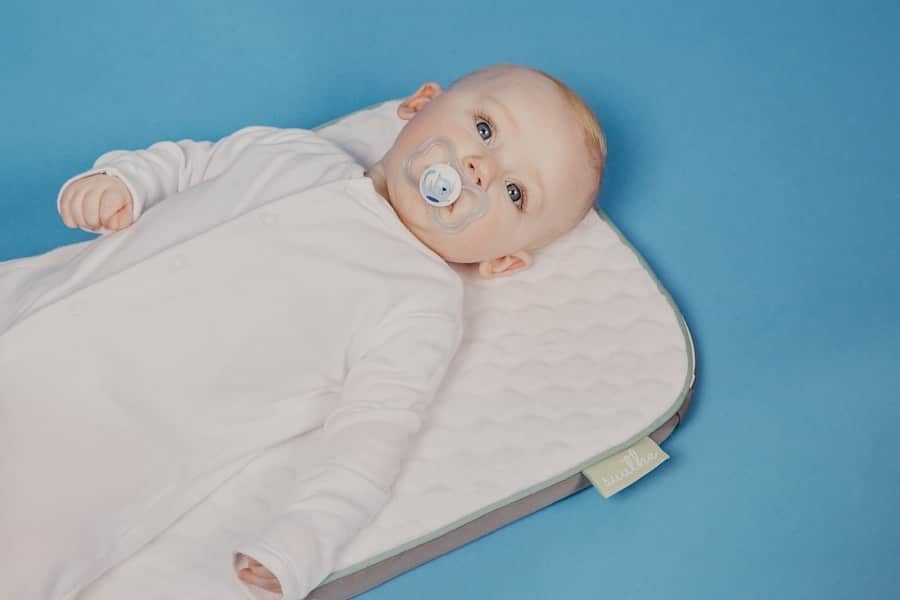The Internet of Things (IoT) has revolutionized various sectors by interconnecting devices and enabling them to communicate and share data seamlessly. This technological advancement has found its way into the realm of baby monitoring systems, transforming how parents keep an eye on their little ones. Traditional baby monitors, which primarily relied on audio or basic video feeds, have evolved into sophisticated IoT-enabled devices that offer a plethora of features designed to enhance parental peace of mind.
These modern systems not only provide real-time monitoring but also integrate advanced functionalities such as sleep tracking, environmental monitoring, and even health metrics. The integration of IoT into baby monitoring systems signifies a shift towards a more connected and responsive approach to childcare. Parents today can access a wealth of information about their baby’s well-being through their smartphones or tablets, allowing for greater flexibility and control.
This evolution is particularly significant in a world where parents often juggle multiple responsibilities, making the ability to monitor their child remotely an invaluable asset. As we delve deeper into the advantages and features of IoT baby monitoring systems, it becomes evident that these innovations are reshaping the landscape of childcare.
Key Takeaways
- IoT revolutionizes baby monitoring systems by enabling remote monitoring and real-time alerts through connected devices.
- Advantages of IoT in baby monitoring include enhanced convenience, improved accuracy, and the ability to track multiple parameters simultaneously.
- Enhanced safety features in IoT baby monitoring systems include temperature and humidity sensors, motion detection, and video surveillance.
- Integration of IoT with baby monitoring devices allows for seamless connectivity with smartphones, tablets, and other smart home devices.
- Remote monitoring and alerts in IoT baby monitoring systems provide parents with peace of mind and the ability to respond quickly to any potential risks or emergencies.
Advantages of IoT in Baby Monitoring
One of the most compelling advantages of IoT in baby monitoring is the ability to provide real-time data and insights. Unlike traditional monitors that merely transmit sound or video, IoT-enabled devices can collect and analyze a variety of data points, including temperature, humidity, and even the baby’s heart rate. This comprehensive approach allows parents to make informed decisions about their child’s environment and health.
For instance, if a baby monitor detects a sudden drop in room temperature, it can send an alert to the parent’s smartphone, prompting them to take action before the child becomes uncomfortable. Moreover, IoT baby monitors often come equipped with machine learning algorithms that can learn from the baby’s patterns over time.
For example, if a monitor notices that a baby tends to wake up at certain times during the night, it can suggest adjustments to the bedtime routine or environmental settings to promote better sleep. This level of customization not only enhances the monitoring experience but also empowers parents with actionable insights tailored to their child’s unique needs.
Enhanced Safety Features in IoT Baby Monitoring Systems

Safety is paramount when it comes to caring for infants, and IoT baby monitoring systems are designed with this principle in mind. Many of these devices incorporate advanced safety features that go beyond basic monitoring capabilities. For instance, some models include motion detection technology that can alert parents if their baby moves out of a designated safe zone within the crib or nursery.
This feature is particularly beneficial for parents who may be concerned about their child’s safety as they begin to explore their surroundings. Additionally, IoT baby monitors often integrate with smart home systems, allowing for enhanced safety measures. For example, if a monitor detects unusual sounds or movements, it can trigger other smart devices in the home, such as lights or alarms, to alert parents or caregivers.
This interconnectedness creates a comprehensive safety net that ensures parents are always aware of their child’s status. Furthermore, many IoT baby monitors come with two-way audio capabilities, enabling parents to communicate with their child from another room or even while away from home, providing reassurance and comfort to both parties.
Integration of IoT with Baby Monitoring Devices
The integration of IoT technology with baby monitoring devices has led to a new era of interconnectedness that enhances the overall user experience. Many modern baby monitors can connect seamlessly with smartphones, tablets, and other smart devices through dedicated applications. This connectivity allows parents to access live feeds, receive notifications, and control various settings from virtually anywhere.
For instance, a parent at work can check in on their sleeping baby via a live video feed on their smartphone, ensuring peace of mind throughout the day. Moreover, the integration extends beyond mere connectivity; it encompasses compatibility with other smart home devices as well. For example, an IoT baby monitor can work in tandem with smart thermostats to maintain an optimal sleeping environment for the baby.
If the monitor detects that the room temperature is too high or too low, it can communicate with the thermostat to adjust the temperature accordingly. This level of integration not only simplifies parenting tasks but also promotes a healthier living environment for infants.
Remote Monitoring and Alerts in IoT Baby Monitoring Systems
Remote monitoring capabilities are one of the standout features of IoT baby monitoring systems. Parents can stay connected with their babies even when they are not physically present in the same location. This is particularly advantageous for working parents or those who need to step out for errands while leaving their child in the care of a babysitter or family member.
With just a few taps on their smartphones, parents can access live video feeds and audio streams, allowing them to monitor their child’s activities in real time. In addition to live monitoring, IoT baby monitors are equipped with sophisticated alert systems that notify parents of any significant changes in their baby’s condition or environment. For instance, if a monitor detects excessive noise levels or unusual movements during sleep hours, it can send instant alerts via push notifications or text messages.
Privacy and Security Concerns in IoT Baby Monitoring

While the benefits of IoT baby monitoring systems are substantial, they also raise important concerns regarding privacy and security. The very nature of these devices—constantly transmitting data over the internet—makes them potential targets for cyberattacks. Unauthorized access to a baby monitor could lead to serious breaches of privacy, exposing sensitive information about both the child and the family.
Instances of hackers gaining access to baby monitors have been reported, leading to distressing situations for parents. To mitigate these risks, manufacturers are increasingly implementing robust security measures such as end-to-end encryption and secure authentication protocols. Parents must also take proactive steps to protect their devices by regularly updating firmware and using strong passwords.
Additionally, it is crucial for parents to understand the privacy policies associated with their chosen devices and ensure that they are comfortable with how their data will be used and stored. As technology continues to evolve, ongoing discussions about privacy and security will be essential in shaping the future of IoT baby monitoring systems.
Future Developments in IoT Baby Monitoring Systems
The future of IoT baby monitoring systems is poised for exciting advancements as technology continues to evolve at a rapid pace. One area of development is the integration of artificial intelligence (AI) into these devices. AI could enable more sophisticated analysis of data collected by baby monitors, allowing for predictive insights into a child’s health and behavior patterns.
For instance, AI algorithms could analyze sleep data over time to identify potential sleep disorders or developmental concerns early on. Another promising avenue is the incorporation of health monitoring features that go beyond basic vital signs tracking. Future IoT baby monitors may include sensors capable of measuring oxygen levels or detecting signs of respiratory distress.
Such innovations would empower parents with critical health information and facilitate timely interventions when necessary. Additionally, as smart home technology continues to advance, we may see even greater integration between baby monitors and other household devices, creating a fully automated environment that caters to both safety and comfort.
The Impact of IoT on Baby Monitoring Safety
The impact of IoT on baby monitoring safety cannot be overstated; it has fundamentally transformed how parents approach childcare in an increasingly connected world. With enhanced features such as real-time monitoring, remote alerts, and advanced safety measures, these systems provide unparalleled peace of mind for caregivers. As technology continues to advance, we can expect even more innovative solutions that prioritize both safety and convenience.
However, as we embrace these advancements, it is crucial for parents to remain vigilant about privacy and security concerns associated with IoT devices. By understanding how these systems work and taking proactive measures to protect their data, families can fully leverage the benefits of IoT baby monitoring while ensuring their child’s safety remains paramount. The future holds great promise for further developments in this field, paving the way for smarter solutions that enhance both parenting experiences and child safety.
In a related article discussing the top trends in digital marketing for 2023, it is highlighted how the Internet of Things (IoT) is revolutionizing the way businesses connect with consumers. The Role of IoT in Creating Safer Baby Monitoring Systems is a prime example of how this technology is being utilized to enhance safety and security in everyday life. To learn more about the latest trends in digital marketing, check out this article.
FAQs
What is IoT?
IoT stands for Internet of Things, which refers to the network of physical devices, vehicles, home appliances, and other items embedded with electronics, software, sensors, actuators, and connectivity which enables these things to connect and exchange data.
How does IoT contribute to creating safer baby monitoring systems?
IoT enables the integration of various sensors and devices to monitor a baby’s environment, such as temperature, humidity, and movement. This data can be transmitted to caregivers in real-time, allowing for immediate response to any potential safety concerns.
What are the benefits of using IoT in baby monitoring systems?
IoT allows for remote monitoring of a baby’s environment, providing caregivers with peace of mind and the ability to respond quickly to any safety issues. It also enables the integration of smart devices, such as cameras and alarms, to enhance the safety and security of the baby’s environment.
What are some examples of IoT-enabled baby monitoring devices?
Examples of IoT-enabled baby monitoring devices include smart baby monitors with video and audio capabilities, wearable sensors that track a baby’s vital signs, and smart thermostats and humidifiers that maintain a safe and comfortable environment for the baby.
What are the potential risks or challenges associated with IoT in baby monitoring systems?
Potential risks include privacy and security concerns related to the collection and transmission of sensitive data. There is also the risk of device malfunctions or connectivity issues that could impact the reliability of the monitoring system. It is important for caregivers to carefully consider these factors when choosing and using IoT-enabled baby monitoring devices.

